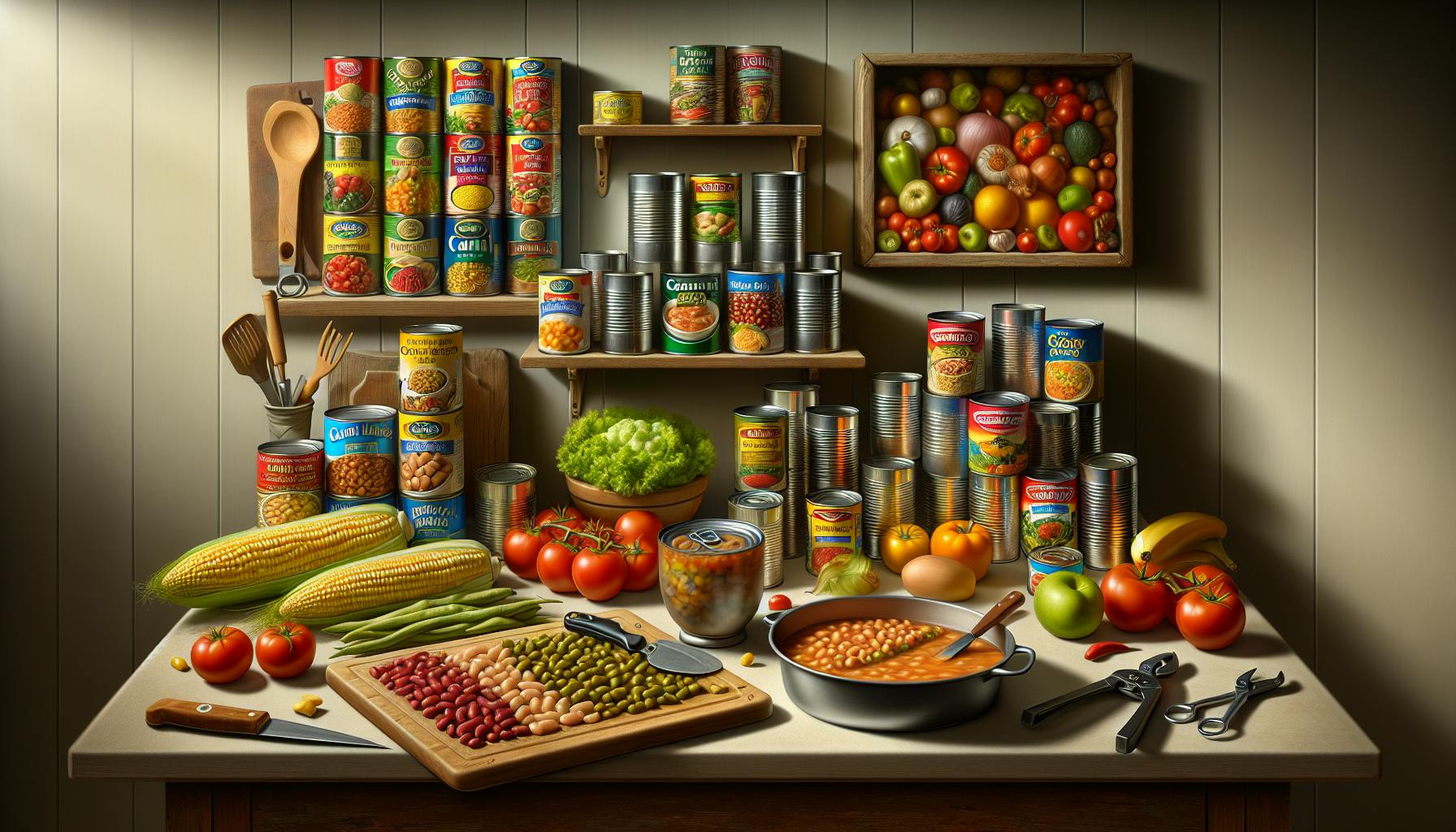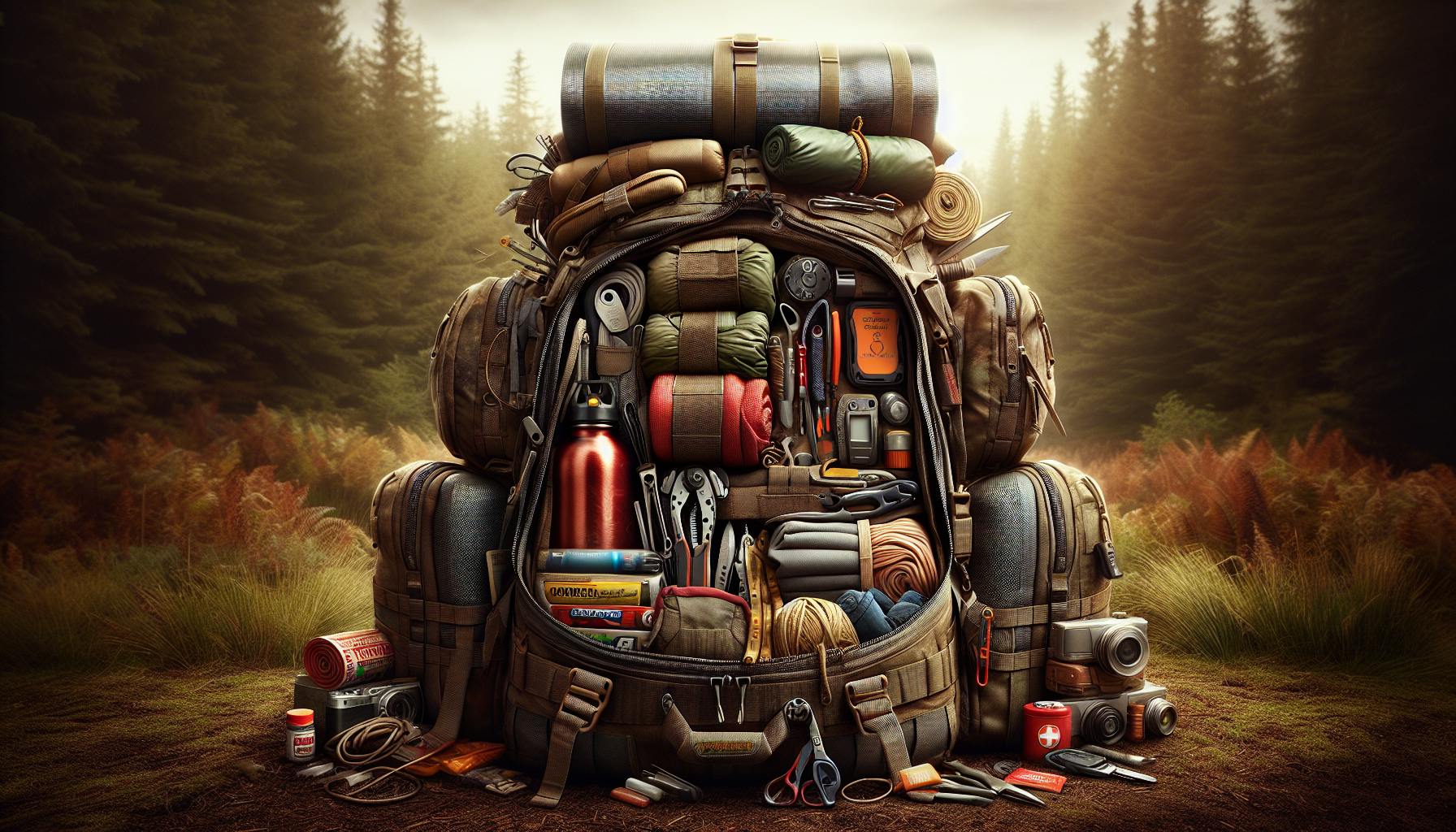When it comes to stockpiling food for emergency preparedness, most people would agree that having nutritious, long-lasting essentials is crucial.
By focusing on shelf-stable foods that pack nutritional value, you can build a 25-year stockpile to sustain your family through any crisis.
In this post, you'll discover the ultimate list of long term survival foods to store, from core staples to comfort foods and preparation essentials. You'll learn key selection criteria, storage strategies, and best practices for maintaining variety and freshness over time.
Introduction to Long Term Survival Food Essentials
Having a stockpile of long-lasting foods is crucial for emergency preparedness. The right survival foods can sustain good health for years when stored properly. This guide covers the key traits to look for and the best food types to include in your long term emergency supply.
Defining Long Term Survival Foods
Long shelf life is the most critical trait for survival foods. The best options can last 25+ years when stored correctly. Essential features include:
- Long shelf life: 25-30 year expiration dates
- Nutrient density: High in protein, complex carbs, healthy fats
- Macronutrient profile: Balance of carbs, protein and fat
- Micronutrients: Vitamins, minerals and antioxidants
- Low moisture: Under 10% moisture content
- Compact: Easy to store and transport
- Preparation: Simple to cook with water
Choosing foods with these characteristics ensures you have nutritious, sustaining meals through any extended crisis.
Best Food Types for Long Term Storage
The most reliable foods for decades of shelf life include:
- Beans - High in plant-based protein and fiber. Choose dry beans and legumes.
- Rice - Go with white or brown rice. The latter has more nutrients.
- Oats - Steel cut or rolled oats keep extremely well.
- Wheat - Whole berries or flour store for 30 years+.
- Freeze-dried produce - Fruits and veggies retain more nutrients than canned.
Sticking to these simple staples means your survival meals will be nutritious and satiating for years to come.
Tailoring Your Emergency Food Supply to Your Family
Calculate how much food you need based on:
- Number of people
- Ages and calorie needs
- Length of crisis (weeks, months, years)
- Food restrictions (allergies, diets)
A good baseline is 2,000 calories per person daily. Build your reserves to support your household through potential disasters.
Storing Foods Properly for Maximum Freshness
Use best practices for storing survival foods:
- Oxygen absorber packets
- Food-grade plastic buckets or Mylar bags
- Cool, dark place (60-70°F)
- Low humidity
This prevents moisture, pests, light exposure and oxygen degradation for decades of shelf life.
Incorporating Freeze-Dried Items in Your Survival Kit
Freeze-dried fruits, veggies and meat provide added nutrition and convenience:
- Higher vitamin content than canned
- Long 25+ year shelf life
- Lightweight, compact packaging
- Just add water for preparation
Having some freeze-dried produce and protein sources supplements staple survival foods for better health.
What is the best food to stockpile?
When building your emergency food supply, focusing on shelf-stable foods with a long shelf life is key for preparedness. Some of the best options to stockpile include:
Canned and Dried Goods
Canned meats like chicken, tuna, and salmon are packed with protein and can last 2-5 years unopened. Canned fruits, vegetables, beans, and soups also have multi-year shelf lives. Opt for low-sodium versions when possible. Dried goods like beans, lentils, rice, oats, pasta, and baking mixes are inexpensive and can last 10+ years if stored properly.
Freeze-Dried and Dehydrated Foods
Freeze-dried fruits, vegetables, meats, and full meal pouches have shelf lives of 25+ years. Though more expensive, they are nutritious and lightweight. Dehydrated fruits and veggies are also great for snacks.
Fats and Oils
Fats like cooking oil, shortening, and nut butters supply energy and calories. Opt for cold-pressed oils stored in cool, dark places. Hard fats last longer than oils.
Water and Beverages
Store at least 1 gallon of water per person per day. Also stock shelf-stable beverages like boxed milk, juice, electrolyte mixes, coffee, and tea.
When building your stockpile, focus on nutritional balance across food groups and caloric needs. Track expiration dates and "eat what you store". Prioritizing non-perishable essentials with long shelf lives ensures you have reliable access to critical resources when needed most.
What survival food has the longest shelf life?
Freeze-dried meat is considered the gold standard for long-term survival food storage. Properly packaged and stored, freeze-dried meat like beef, chicken, or turkey can last 25+ years. This unmatched shelf life makes freeze-dried meat an essential component of any emergency food supply.
There are a few key reasons why freeze-dried meat has such exceptional longevity compared to other survival foods:
-
Removal of moisture - By freeze-drying meat, almost all moisture is extracted, leaving only about 2-5% remaining. This lack of moisture prevents bacteria growth and oxidation.
-
Vacuum sealing - After freeze-drying, the meat is vacuum sealed in thick, multi-layer pouches that are impermeable to oxygen and light. This protects nutritional integrity.
-
Cool, dry storage - Storing pouches of freeze-dried meat in a dark, room-temperature location optimizes shelf life. The meat remains inert inside the oxygen-free pouches.
In addition to its 25+ year shelf life, freeze-dried meat offers other practical benefits for survival situations:
- Highly nutritious, providing protein, vitamins, and minerals
- Lightweight and portable compared to canned goods
- Easy to prepare by just adding hot water
- Tastes similar to fresh when reconstituted
With its exceptional longevity and great taste, freeze-dried meat like beef and chicken makes an ideal addition to any emergency food supply. It's the ultimate long-term survival food for peace of mind.
What are 7 perfect foods for survival?
When building an emergency food supply, it's important to focus on shelf-stable foods that provide nutritional value, long shelf life, and ease of preparation. Here are 7 of the best long term survival foods to keep stocked:
Peanut Butter
An excellent source of protein, fats, and calories, peanut butter has a shelf life of 3-5 years when unopened. Look for natural peanut butter brands without hydrogenated oils. Peanut butter is versatile - eat it with crackers, bread, or even straight from the jar in an emergency.
Whole-Wheat Crackers
Whole grain crackers made without hydrogenated oils can last 1-2 years on the shelf. Pair with peanut butter for added calories and nutrition. Whole-wheat crackers provide complex carbs, fiber, and B vitamins.
Nuts and Trail Mixes
High in protein and healthy fats, mixed nuts and trail mixes can last up to a year when stored properly. The best picks are raw almonds, walnuts, cashews, and nut mixes without added oils or sweeteners.
Cereal
Choose whole grain cereals and store in airtight containers to extend shelf life up to a year. Opt for low or no sugar varieties. Combine cereal with nonfat powdered milk and dried fruit for a balanced breakfast.
Granola Bars and Power Bars
Store-bought granola bars and power bars heavy on oats, nuts, dried fruit, and dark chocolate make convenient high-calorie snacks with a shelf life around 9 months. Avoid bars with hydrogenated oils.
Dried Fruits
Dried fruits like apricots and raisins are tasty sources of antioxidants, potassium, fiber, and carbs. Properly stored, they can last up to a year. Add to trail mixes or cereal for flavor and nutrition.
Canned Tuna, Salmon, Chicken
High in protein, omega-3s, calcium, and B vitamins, canned fish and chicken can safely be stored 2-5 years. Choose water or oil packed varieties with minimal sodium.
sbb-itb-b932644
Which food is best for long life storage?
When it comes to best long term survival food, there are certain types of foods that have naturally long shelf lives and are ideal for emergency storage. Some top options include:
Fruits, Vegetables, and Tubers
Certain produce like potatoes, winter squash, onions, and apples can last for months when stored properly in cool, dark places. Dehydrating or freeze-drying fruits and veggies can extend their shelf life even further.
Nuts
Nuts like peanuts, almonds, and walnuts can last up to a year when stored in an airtight container in the pantry. They provide essential fats and proteins.
Jerky
Dehydrated, salted meats like beef jerky can keep for 1-2 years when sealed from moisture and oxygen. Jerky offers protein and nutrients for survival situations.
Canned/Jarred Foods
Properly processed and sealed canned goods like beans, tomatoes, tuna, and vegetables can have shelf lives of at least 2-5 years. They offer convenient, ready-to-eat nutrition.
Dried Pasta/Rice/Grains
If kept dry and sealed, products like pasta, rice, oats, and other grains can last for years with negligible nutrient loss over time. They are versatile survival carb sources.
Prioritizing non-perishable, nutrient-dense foods that require minimal preparation is key for emergency food supply. Conducting regular inventory checks and proper storage are also vital for maximizing shelf life.
Building a 25-Year Emergency Food Supply
As preppers, having a robust long-term food supply is essential for ensuring our families' safety and security in an emergency. When building your stockpile, focus on nutrient-dense foods with a long shelf life, such as whole grains, beans, lentils, and freeze-dried produce.
Choosing Survival Foods with Long Shelf Life
Prioritize non-perishable items that retain nutritional value over time. Some great options include:
- Whole grains like rice, quinoa, oats, wheat berries
- Dried beans and lentils
- Freeze-dried fruits and vegetables
- Nuts and nut butters
- Canned meats like tuna, salmon, chicken
- Broths and soups
- Comfort foods like pasta, honey, peanut butter
Rotate and eat the perishable items first while continuing to build up your supply of grains, legumes and freeze-dried items that can last 25+ years when properly stored.
Calculating Quantities for a Family of 4
A good rule of thumb is to store at least 400 lbs of grains, 400 lbs of legumes, 100 lbs of fats/oils, and 150 lbs of milk/dairy products per adult family member. For a family of 4, that equates to:
- 1,600 lbs of whole grains
- 1,600 lbs of beans/lentils
- 400 lbs of fats/oils
- 600 lbs milk/dairy
Supplement with freeze-dried produce, canned goods, comfort foods, and vitamins.
The Role of Survival Food Kits
Pre-packaged food kits like ReadyWise provide balanced nutrition in an easy grab-and-go format. They give you a solid nutritional foundation. However, for true long-term preparedness, bulk ingredients allow you to tailor your supply to your family’s needs and save money.
Use kits to supplement your bulk supply. Rotate and replace them as you use them over the years.
Maintaining Variety and Taste
To prevent appetite fatigue over decades, store a wide variety of ingredients and regularly rotate items into your daily menu. Some ideas:
- Multiple types of beans, grains, freeze-dried produce
- Spices, herbs and seasonings
- Comfort foods like honey, pasta sauce, peanut butter
- Canned fruits and vegetables
Get creative with recipes and meal planning!
Rotation and Upkeep
- Date all incoming food with purchase date
- Establish a first in, first out rotation system
- Inspect items yearly for expiration dates and damage
- Replace anything over 5 years old
- Keep storage areas cool, dark and pest free
Following proper storage and rotation practices ensures you can rely on your food supply for decades to come.
The Ultimate Emergency Food Supply List
Having a well-stocked emergency food supply is crucial for survival preparedness. When building your stockpile, focus on nutrient-dense foods with a long shelf life that are easy to store and prepare.
Core Staples for Sustenance and Energy
Prioritize non-perishable staples that provide calories and macronutrients:
- Whole grains like rice, quinoa, oats
- Dried beans and lentils
- Canned meats like tuna, salmon, chicken
- Powdered milk and eggs
- Nuts and dried fruits
These foods last for years when properly stored and can be cooked with minimal fuel and preparation.
Nutritional Boosters and Supplements
To prevent malnutrition, also stock:
- Multivitamins
- Vitamin C supplements
- Powdered greens like spirulina
- Electrolyte mixes
Rotate these every 2-3 years to maintain freshness.
Comfort Foods and Morale Boosters
Store some familiar comfort foods like:
- Honey
- Peanut butter
- Jams and jellies
- Hard candies
- Tea and coffee
These items lift moods and provide sweetness.
Preparation and Cooking Essentials
Have equipment to prepare meals without power:
- Camping stove and fuel
- Mess kits and utensils
- Manual can opener
- Bottled water or water filtration system
Water Purification and Storage Solutions
Store enough water for 2 weeks per person. Ensure purity with:
- Water filtration system (gravity filter, Lifestraw, etc.)
- Water purification tablets
- Bleach
Rotate water every 6 months.
Focusing on long-lasting nutritious staples, supplements, comfort foods, and preparation tools will help build an emergency food supply to reliably sustain your family.
Survival Gear Beyond the Pantry
When building your long-term food storage, it's important to look beyond just filling your pantry. A well-rounded emergency preparedness plan requires additional survival gear to complement your food supplies and ensure you are fully equipped to handle a crisis situation.
Essential Tools and Supplies
Gathering critical tools and gear will provide the means to utilize your food stores and meet other basic needs if the grid goes down. Here are some of the most essential items:
-
Knives - A good quality survival knife and multi-tool are invaluable for preparing food, making shelters, and countless other tasks. Choose durable, stainless steel blades.
-
Fire Starters - From stormproof matches to flint strikers, have multiple ways to start a fire to cook, purify water, and stay warm. Practice fire starting skills now.
-
Rope and Cordage - Useful for erecting shelters and animal snares. Paracord or mason line are versatile options.
-
Tarps / Tents - Choose durable, waterproof shelters to protect from the elements and have backup housing if needed.
-
Water Purification Supplies - Stock water purification tablets, bleach, filters, or other means to ensure safe drinking water.
First Aid and Medical Supplies
Being prepared to treat injuries and illness without access to hospitals and pharmacies is a major aspect of emergency readiness:
-
First Aid Kit - Well-stocked kits can handle cuts, burns, sprains and more. Include gauze, bandages, ointments.
-
Medications - Stock up on critical prescription medications plus OTC pain/fever relievers, anti-diarrheals, etc.
-
Sanitation and Hygiene - Hand sanitizer, toilet paper, toothpaste, feminine products, etc will be valued commodities.
Communication and Navigation Tools
When normal infrastructure fails, having backup communication and navigation equipment is vital:
-
Emergency Radios - Crank or solar-powered radios access AM/FM/NOAA bands without batteries/power.
-
Two-Way Radios - Allow communication with family/group members locally. Choose long-range models.
-
Maps and Compasses - Low-tech but essential navigation if GPS fails. Learn proper map reading skills.
Clothing and Personal Protection
Plan clothing, shoes, and gear to enable working and surviving outdoors year-round:
-
Insulated Outerwear - All-weather coats, hats, gloves to regulate body temperature in harsh conditions
-
Sturdy Footwear - Waterproof hiking boots or work boots to traverse rough terrain.
-
Safety Gear - Stock protective glasses, dust masks, gloves for handling debris and hazardous materials.
-
Weaponry - Guns, ammunition, pepper spray to protect yourself and property if needed.
Power Sources and Lighting
Prepare for loss of electricity to preserve perishables, recharge devices, illuminate spaces, and more:
-
Solar Chargers and Batteries - Store power from the sun to charge phones, radios, flashlights.
-
Candles and Oil Lamps - Simple lighting without electricity. Use safely.
-
Headlamps / Flashlights - Quality LED or crank lights last for hours to navigate in the dark.
Expanding your preparedness supplies beyond just food ensures you have well-rounded gear to utilize your long term storage and survive if the grid goes down. Invest in quality tools, medical supplies, communications equipment, protective apparel and off-grid power sources. Practicing with survival gear develops critical skills as well. With training and the right supplies, your family can better weather any extended emergency.
Conclusion: Sustaining Life with Long Term Survival Food
Long term survival food is essential for maintaining health and morale during an emergency. When building your food supply, focus on variety, nutritional balance, and practicality.
Emphasizing Nutritional Balance and Diversity
It's important to have a diverse range of foods in your supply to ensure you get adequate nutrition. Include fruits, vegetables, grains, proteins, and fats. Variety also helps make meals more enjoyable and prevents boredom over time. Consider freeze-dried and dehydrated produce as well as canned goods.
Strategies for Regular Evaluation and Rotation
Check expiration dates on your survival food twice a year and replace anything that's expired. This ensures freshness and prevents waste. Also try incorporating some long-shelf life items like rice, beans, and canned tuna into regular meals. This helps you become familiar with these items and cycles through the supply.
Integrating Survival Food into Daily Life
Get comfortable using survival food items in everyday cooking. Try recipes with rice, beans, pasta, or canned vegetables. This helps reduce intimidation if you ever need to rely on your emergency supply. It also ensures you don't end up throwing away expired food that could have been consumed earlier.
Preparing for the Unpredictable
No one knows exactly what an emergency situation will require in terms of food. Be ready to adapt your plan if circumstances change. Have basic ingredients like flour, oil, salt and basic spices on hand so you can modify recipes with whatever is available. Staying flexible is key.
Final Thoughts on Long-Term Preparedness
Building an emergency food supply takes forethought but is essential preparation. Focus on nutritional variety, rotation, and integration into daily life for the best chance of sustainability. View it as one component of comprehensive emergency planning. With the right strategy, long term food storage can literally sustain life in difficult times.


